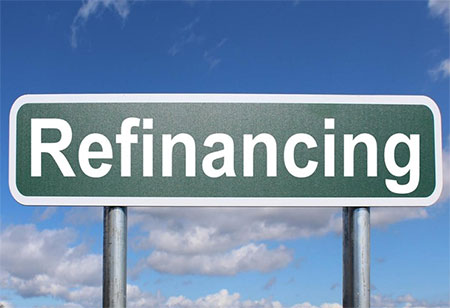
Refinansiering Av Lan - A Guide to Refinancing Loans

 Taking out a loan happens to everyone at one point or the other. It could either be taken from a friend or a financial institution like the bank. The purpose is to cover up certain areas that the monthly income could not address at the moment. There are times when one needs to borrow more money as the need arises. Before a new loan can be issued, the old one must be cleared.
Taking out a loan happens to everyone at one point or the other. It could either be taken from a friend or a financial institution like the bank. The purpose is to cover up certain areas that the monthly income could not address at the moment. There are times when one needs to borrow more money as the need arises. Before a new loan can be issued, the old one must be cleared.
This is where refinancing of loan comes in. This article will explain in detail the subject matter. It will be a guide to all you need to know when you want to refinance your loans. Let’s dive into more details.
What It Means to Refinance a Loan
Loan refinancing involves replacing an existing debt with a new one under different terms and conditions. The initial agreement for the old debt is replaced with a new loan and updated agreement enabling the borrower to redo their loan. By doing this, the borrower gets a lower monthly payment, the terms and condition is extended or the payment structure is made more convenient.
One major reason why consumer refinance their loans is to get low interest rates when paying back. Although this may be a good thing as it enables the payment to be faster, it could also have some hidden disadvantages. One of the disadvantages is that the overall money paid back at the end of the loan term is very high because of the extended time. This is as a result of the interest it has accumulated.
However, this low interest does not apply to all loans like auto and mortgages. These sometimes come with prepayment fines, so it becomes difficult to enjoy the refinansier (refinance) benefit due to the extra charges already involved. Therefore, when planning to refinance a particular debt, it is good to ask certain questions so as not to get stuck during repayment.
Let’s look at some of the types of loans we have and the benefits of refinancing them. This will help you know how to apply for one and what it takes to refinance them. Every loan has its specific requirements when it comes to refinancing. Going for one means you clearly understand the terms and conditions involved.
Student Loan
Student loan refinancing is commonly used to merge several loans into a single payment. These debts may include subsidized, unsubsidized, and federal loans. The interest rate of each of them is quite different where the borrower will have to make two different payments monthly. When it is refinanced into one lender, it is easier to manage the debt and also lower the interest.
 Personal Loan
Personal Loan
Refinancing this type of loan simply means you apply for another one that offers better terms. Alternatively, you can apply for a credit card particularly one that has a 0% intro APR (Annual Percentage Rate). This APR is a percentage that makes it easy for borrowers to be able to compare the exact cost of different loan offers from different financial institutions.
Comparing the percentage of each lender makes it easy to choose one that will be of great benefit. Therefore, when it’s time to refinance your loan, ensure you compare the repayment terms, fees, and APR. You wouldn’t want to end up with a bad deal now, would you?
Credit Cards
Most times people often use their loan to refinance the debt incurred on their credit card. Click here to learn how credit cards work. The interest on credit cards is usually monthly. By using your loan to pay off your credit card debt, you will likely get a more manageable and affordable way to clear your debt.
Auto Loan
This type of loan is for the purchase of a vehicle. Therefore, refinancing this debt helps get you a restructured loan agreement to get your finances back on track. However, some banks may demand for specific requirements like mile caps, limits on the outstanding balance, and age-of-car restrictions which may serve as a disadvantage.
If you’re having issues repaying your debt, contact the financial institution you’re using. Explain your financial situation to them. They will be in the best position to proffer an option that will suit your repayment plan.
Small Business Loan
This type of loan is taken to fund a small business for different purposes like startup capital, business expansion, buying of equipment, etc. Therefore, refinancing will you get better terms and help you manage your financial situation effectively. Ensure, you carefully consider the benefits, costs, and long-term implications.
 Mortgage
Mortgage
This type of loan is usually to purchase land or a house. A borrower who thinks of refinancing is simply looking for ways to shorten the term length and to reduce the monthly payments. Doing that does not work as planned due of the closing cost seems to be high.
The closing cost is the summed-up fee which includes appraisal, loan application, title search, and so on. These costs are usually paid when the property has been bought. Therefore, when refinancing, the monthly payments are quite high because of this.
How to Go About the Process of Refinancing a Loan
Although the process of replacing an old debt with a new loan may differ. Based on the terms and conditions of your current financial institution and the one you may be considering using, there are always ways to go about it. Some of those steps are:
1. Review the details of your existing lender’s terms and conditions to know how much you’re repaying. Ensure you are aware of the interest rate, the terms, and how much you are expected to pay back monthly. Failure to do so can put you in a tight fix.
2. Ensure you check for prepayment fines especially if your loan is for a mortgage or car. Doing this will save you from the heavy interest outweighed by the early cost of termination. Note, that these prepayment fines are fees that some lending financial institutions charge for them to regain the loss on the interest when your debt is paid in time.
3. After properly examining the worth of your current debt, try to compare it with other financial lenders to get the best terms that suit your financial plans. Do not overlook any fee and make sure that you compare the terms of repayment and the interest rate. This will enable ease and convenience during repayment.
Whether you want to change the length of the terms of your loan or you want to reduce the interest rate, there are several options available these days that you can choose from. Considering the emergence of new online lenders ready to contend with banks, they have made available some packages and services modified to address your financial goals. The competition can assist in cutting the loan costs.
The services and packages made available by these new online lenders will help you to answer the question you may have on why refinance. There are several reasons why refinancing is an option when you can’t afford to clear your loan in time after knowing how to go about it. Some of those reasons are:
1. The reduced interest rate.
2. Lower monthly payments plan.
3. Access to equity.
4. Changing your loan type.etc.
 The Pros and Cons of Refinancing a Loan
The Pros and Cons of Refinancing a Loan
The How’s and the Whys are not all there is to know about loan refinancing. There are also several advantages and disadvantages to take note of before finally deciding on whether to refinance or not. Let’s look at some of them.
Pros
1. It might be possible to reduce the monthly payments to an affordable amount.
2. Owing to a debt with an interest rate that changes from time to time, that is it is not fixed, you get a fixed percentage which can offer a monthly payment that you are certain about.
3. One can save some cash on the amount of interest paid at the end of repayment. This could be possible when you refinance your loan to have a reduced payment period.
4. You can have access to offers for low-interest rates if the rates are reduced or you have an improved credit score.
Cons
1. It can take a long time to apply for a new loan to offset an old one. An example of such a loan is a mortgage.
2. This can reduce your credit score record when applying with a new lender.
3. Although prepayment penalties are rare, they could come up and this may negate any potential savings you could receive when refinancing.
4. Although one may have smaller amounts to pay monthly when refinancing for an extended loan term, you will end up spending more on the interest.
It is advisable to weigh the advantages and disadvantages and also your financial goal. If refinancing offers you more advantage, then you can go for it. If it’s not, look for other alternatives.
Conclusion
Loan refinancing can be a strong tool to manage your finances, but you need to assess your specific situation. Search for the best terms and understand the potential risks and costs connected with the process. This article is a proper guide when you are having a financial situation and you don’t know how to go about it. It will give you an insight into some of the loans you can apply for and the advantages of refinancing them.
It will also guide you on how to refinance your loans. After going through all of this, consulting a financial advisor for further clarification will be an addendum. They will be your guide in the refinancing process.